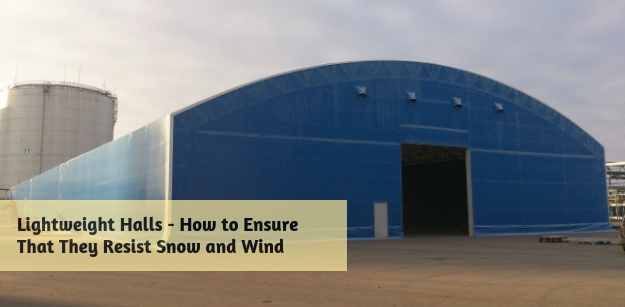Most institutions and companies rely on lightweight halls for various needs like sports and storage. They can also be used at home as temporary garages for vehicles. They range from complete enclosures to simple canopies to provide shade. When they are being installed, experts consider a couple of factors like weather resistance.


While regulating heat is simple if they have a thermal resistance layer, snow and wind remain big challenges for most users. But innovative designers and engineers have come up with some solutions to overcome such challenges.
In the next part of this publication, we will highlight crucial tips to ensure that these halls can resist both snow and wind.
Dome and Round Arched Halls
One thing that you will notice with almost all lightweight temporary structures is that they have a dome and a round-arched top. This is an adaptation to allow the wind to pass through them well. It reduces the resistance unlike blocked structures. Most importantly, they allow more ice to drip on the sides rather than settling on top to reduce weight and pressure. When scraping off the snow on these structures, the work will also be easier since only a little will be accumulated.
Open-Ended
Where possible, these structures are just simple canopies to allow the wind to pass through them. This greatly reduces the effects of strong wind on them. When they need to be enclosed in the case of storms, they allow both ends to be opened when there is strong wind that may threaten them. This can be done by rolling the fabric material up and tying it. They can then be fastened at a later date when the wind is calmer.
Strong Frames
When making lightweight school halls, experts focus on using strong but light frames. Aluminum is lighter than structural steel, but it makes robust frames that will withstand both snow and wind. The frames determine how robust the lightweight hall will be. In most cases, the wind exerts a sideways pressure while the snow will exert downward pressure. Research has shown that aluminum frames are perfect to overcome such pressure.
Fastened Base
To avoid being plucked off the ground by the wind, experts ensure that they fasten both the frames and fabric on the ground using hooks and pegs. Sometimes, they may need to put in permanent clips using mortar where the lightweight halls will be fastened. However, engineering innovation varies depending on the design, ground, and weather in the region.
Water-Resistant Fabrics
Snow is associated with wetness, and water-resistant fabric material is one of the best to use in this case. It will ensure that your items are protected even when the snow starts to melt into water. Some materials are not only resistant to water but snow as well.
With all of the above innovations on lightweight halls and other temporary structures, wind and snow are no longer a challenge. To get such structures, you will need to involve reputable experts because they are the best to fulfill your needs.



